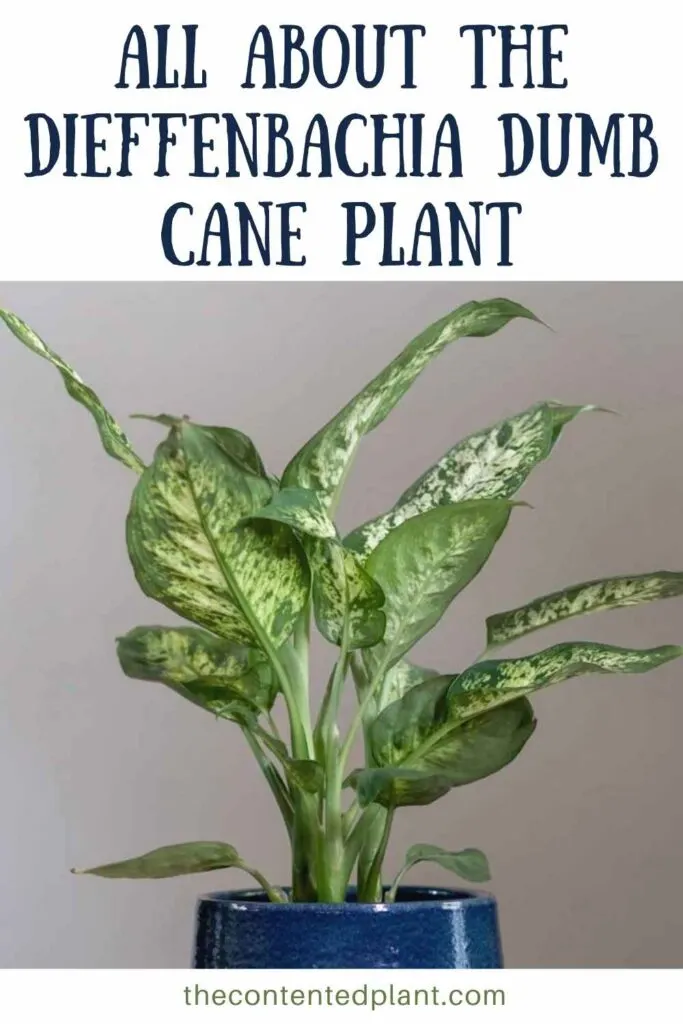Dieffenbachia plants are one of the all time favorite bushes to grow indoors. These striking plants have beautiful foliage and they grow tall. Up to six feet.
Dumb cane (we’ll get to the reason for the name further down), is available in myriad leaf shapes and color variations. There is one out there for you. 🙂
They create lovely, lively, living statements in a large room or patio. They will filter your indoor air and create oxygen for you.
These tropical plants originate in the new world tropics of The West Indies, Mexico and south all the way to Argentina.
In warm climates dumb canes grow well outdoors as landscape or patio plants. However, they prefer stable warm temperatures.
Keep them indoors if your outdoor temperatures fluctuate seasonally.
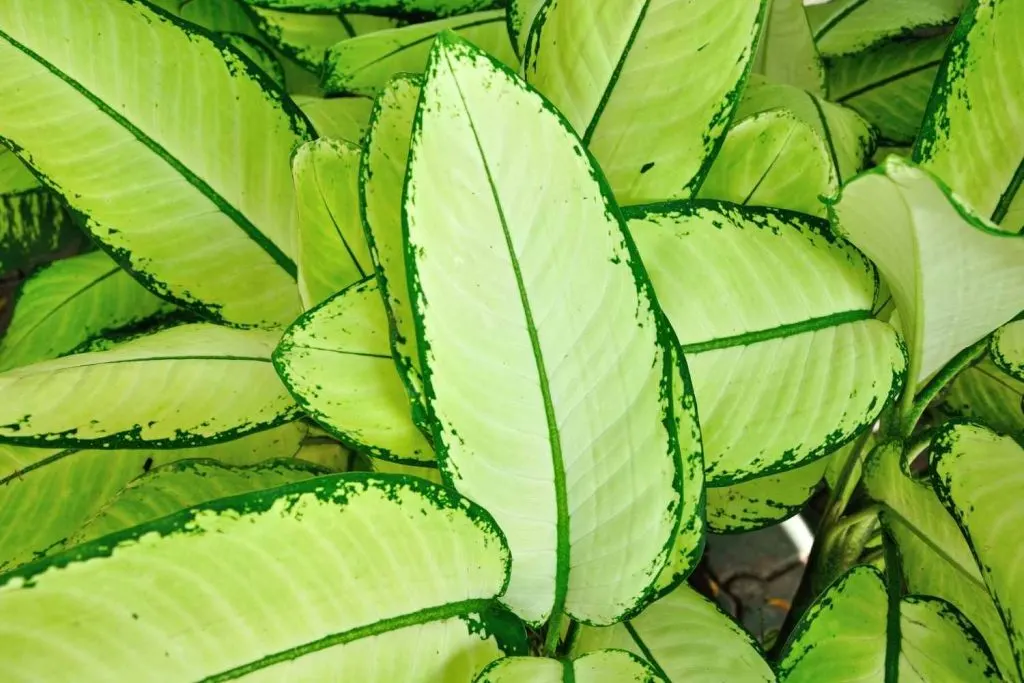
Dumb Cane is Toxic:
Dumb Cane is a terrible derogatory name for a plant, In my Opinion. I could not understand why it is named this. So I researched it.
This common name has a purpose. This is a caution to plant owners. Dieffenbachias, like many houseplants, are poisonous.
They are in the plant family Areacea along with Pothos, Monsteras, philodendrons, coclocasias, alocasias and Peace Lilies. ALL of these popular houseplants plants are poisonous.
Do not put dieffenbachia where kids and pets can chew on it. Dieffenbachia cats, kids and dogs need supervision when in close proximity.
Dumb Cane plants contains raphides. The sap in the plant is highly irritating. So wear gloves and wash hands when you prune it.
If a child or pet chews the leaves or stem, raphides can get into the tissues of the throat and mouth.
This is painful and irritating. But Dumb cane is also known to cause loss of speech for up to two weeks when ingested.
Hence the name.
Keep this plant clear of vulnerable humans and pets.
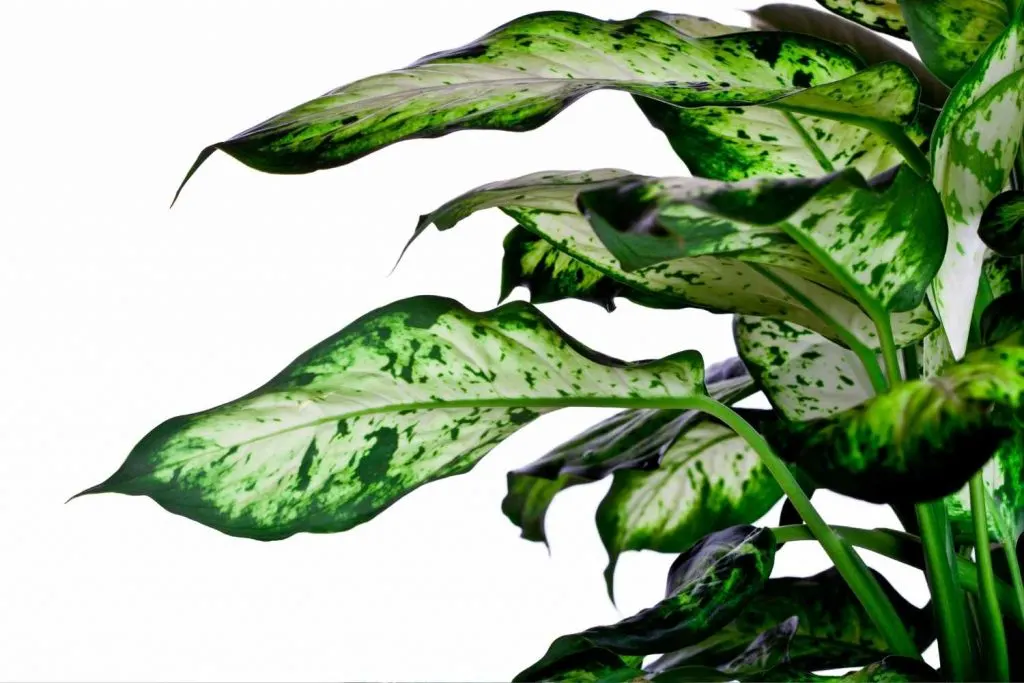
There are MANY colorations and leaf varieties of dieffenbachias. You will find them in almost any plant or garden shop locally.
If you want a particular type and have trouble sourcing it, look on ETSY. They have MANY shops with a LOT of different and interesting dieffenbachia varieties.
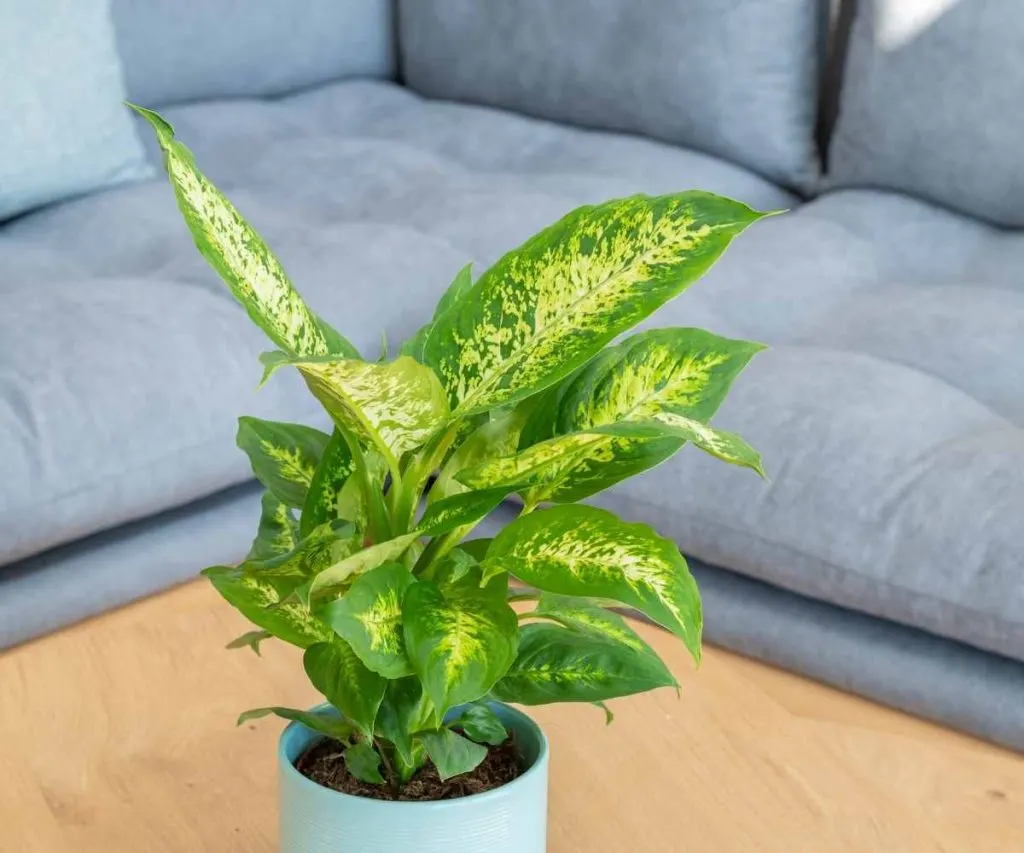
Dumb Cane Plant Care:
Read our complete care guide below to learn all the tips for caring for your dieffenbachia. These are easy care plants that make great gifts for beginner plant owners.
They do flower. Rather like Peace lilies and Anthuriums on tall upright stalks. However, The flowers are not the big draw for this plant. You can just cut them off if you don’t want the plant wasting it’s energy on supporting them.
Dumb Canes are easy to grow because they tolerate neglect, low light and other less than ideal conditions. You CAN kill them by overwatering though. They don’t like that.
TIP: If you’re seeing dumb cane yellowing leaves, you might be overwatering.
Dumb cane propagation is also very simple. Follow the methods In our pothos propagation video at the bottom of this guide for methods that work with the dumb cane.
Dieffenbachia Care Guide
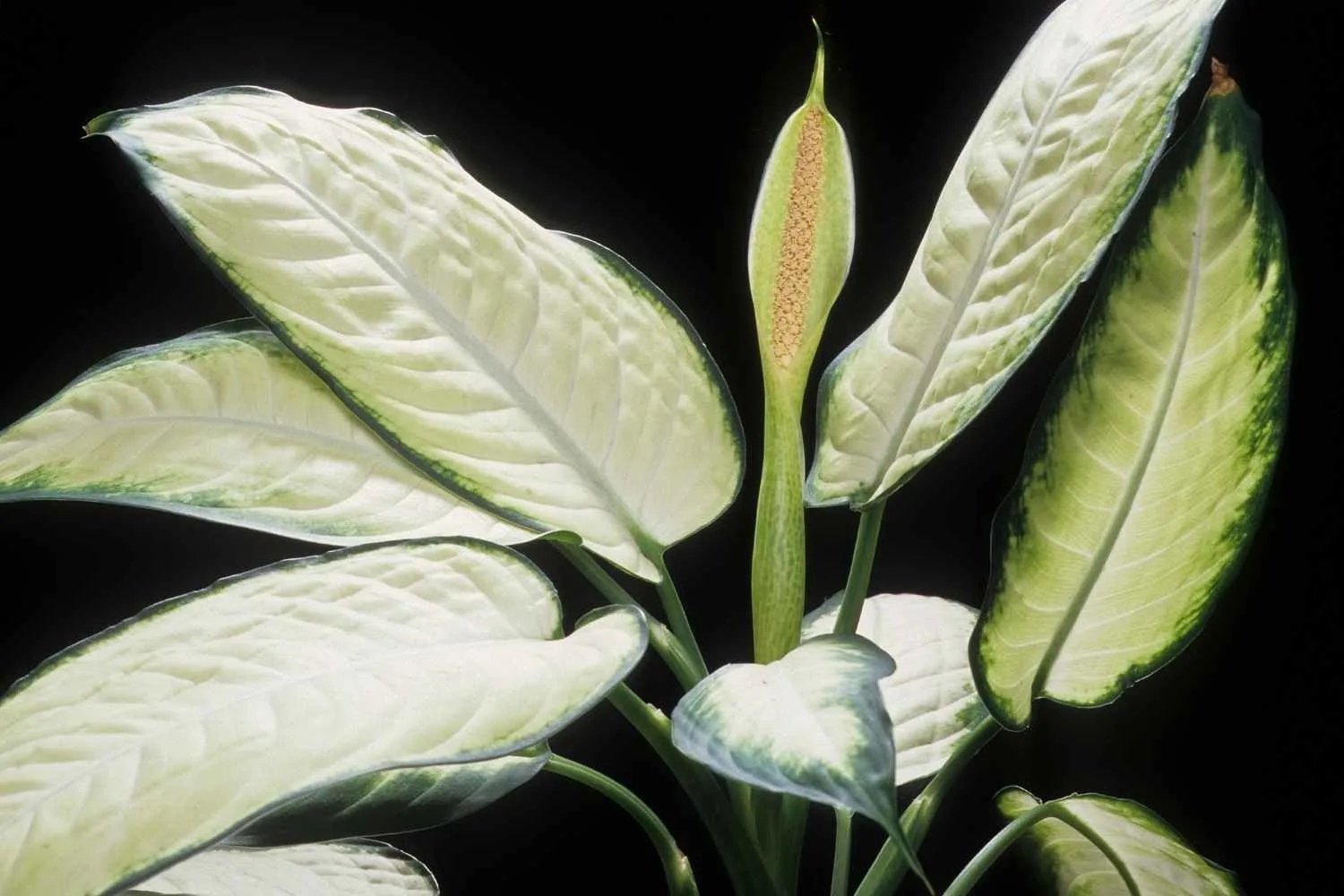
Dieffenbachia plants have only a few basic requirements to remain a happy durable plant.
Dumb cane is available in LOTS of beautiful varities.
This lovely plant is a perfect beginner houseplant. They grow to six feet high with large leafy, bushy foliage.
Materials
Instructions
Soil Preference:
- Dieffenbachias requires a light soil.
- A mix of potting soil and perlite will keep the roots happiest.
- Our mix for dieffenbachias is 50 % potting mix to 50% perlite. However, Any light well draining soil mix will work.
- A heavy soil potting mix is not recommended for dumb cane plants.
Pot Size and Type:
- Dieffenbachias are large and bushy. Grow them in pots that fit the root with a bit of room to grow.
- If you want to encourage faster growth choose a pot about 2 inches wider in diameter than the current pot.
- Any well drained pot can be used. It MUST have drainage.
- Repot every second year or when roots come out the drainage holes on the pot bottom To the next pot size up.
- Don't jump to a huge pot from a small one unless you wish to encourage faster growth. Just go to the next size up pot.
Read About Plant Problems in this section:
Fungus gnats, yellowing leaves and root rot are problems for any plant grown in the incorrect conditions. Click the links to learn more..
Lighting:
- Dumb Cane enjoys indirect bright light.
It will tolerate lower indirect light it if has some brighter moments in the day. - Filtered sunlight from a south window will be appreciated.
- Shield this plant from strong direct light in summer south and west sunny windows. The leaves will burn.
- Tip: Window sheers or blinds can offset some brief periods of high direct light.
Watering:
- Water your Dieffenbachia when the soil is dry down an inch or so. They do not like to be overly wet. Try a watering schedule of every other week.
- Watering is best done on a regular schedule so the plant is not over or under watered. Both can cause stress on the plant.
- This tropical plant enjoys humidity. In dry climates Dumb Canes will thrive with a humidifier nearby. Or set it in your kitchen or bathroom. For a really dry climate frequent misting, plant grouping and pebble trays will help.
- In dormant winter months reduce watering to when the soil is dry down halfway .
How to Fertilize:
- Apply a good quality fertilizer (linked in materials) monthly through Spring and summer.
- Decrease feedings by late Fall and allow the plant to rest through the winter months.
- Look for brown spots on the leaves of your plants. This may indicate an over concentration of salts in the roots from over feeding. It can burn the leaves.
Temperature:
- Keep Dumb Canes at a low of 65 Degrees F. to upward of 85 Degrees F. They like a stable temperature so keep them out of drafty corridors and away from heat vents.
Pruning and Training:
- Pruning will give you a fuller plant with more even growth.
- Occassionally the lower leaves with yellow and fall off as the new leaves set on. Just prune them off.
- If you see more than the occassional yellow leaf you may be overwatering. See plant problems above.
- Sharp Hand pruners are preferred for pruning. They will give a clean cut that will heal quickly.
Leaf Care:
- Dumb canes enjoy occasional leaf washing to keep the stomata (leaf pores) open. this helps them respire and grow better.
- Monthly washing of the leaf surface is also a good idea to keep pests from setting up house on your dumb cane.
Pests:
- Dieffenbachia is not fussy and resists pests. However all plants can get attacked by pests.
- Stress by longterm overwatering, poor light, extreme temperatures and poor soil conditions are contributors to plant stress..
- Spider mites, mealy bugs, scale, thrips and whitefly are the most common houseplant pests you will see.
- Read our post on How to get rid of aphids and other pests with our homemade pesticide soap recipe or neems oil.
- To minimize the possibility of pests be sure to check all nursery plants before bringing them home.
- Quarantine all new plants until you are sure no pests live in them.
- Regular pest inspection and leaf washing with neem oil will also help prevent pest infestations.
How to Propagate Dumb Cane:
- Propagation is easily done through stem cuttings.
- You need a 3 to 6 inch leaf stem with healthy growth.
- Place stem into jar with water. Use tap water that has settled 24 hours in the jar to dissipate harmful chemicals.
- Set the jar in a well lit area.
- After several weeks roots will grow. Allow the roots to get an inch or more in length.
- Plant gently and firmly into pot with proper soil mix.
- Make sure to keep the soil moist until the roots begin to set into the soil.
- Propagation in soil:
- Dumb canes can also be planted directly in soil from a terminal stem cutting. Even leafless stems can be planted.
Notes
watch our video below for more on 3 simple propagation methods. These methods can also propagate dieffenbachias.
Follow Us:
Find us on YouTube, Instagram , Pinterest and TikTok! We love to Plant chat. We also comment, like and occasionally share your content to our daily stories. We’d love to see your plants. Share your joy in your houseplants. Happy Planting!
Recent Posts:
